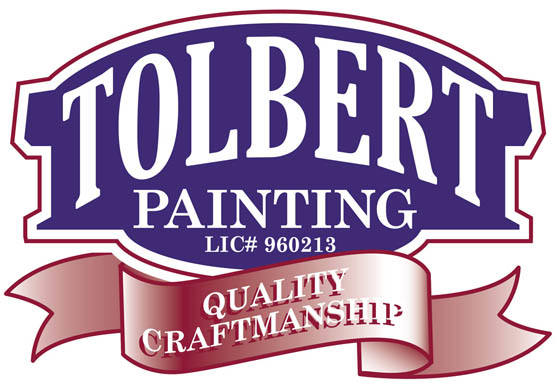Tolbert Painting: How to change
the color of your wood cabinets
Lately, I have been hearing this: “We just bought this house and the cabinets are a light natural wood color and we want them to be dark, is that possible?”
The answer is yes, but with a caveat. Make sure the person saying “yes” is a skilled painter who can prove that he or she can accomplish this feat, otherwise there is a good possibility more damage will occur.
 When houses were first being built in this area (San Luis Obispo County), light color cabinets were popular and good wood (such as Oak, Mahogany, and Maple) was prevalent to build those cabinets. Today, wood like Oak, Mahogany, and Maple has become more scarce, making the price of good wood outside of the normal budget. That’s why I’m seeing more Alder, Ash, and Poplar. So if you have good cabinets made of great wood and they are functional for you, it may be best to keep them and simply have them re-done – a common misconception is that brand new cabinets are always an upgrade.
When houses were first being built in this area (San Luis Obispo County), light color cabinets were popular and good wood (such as Oak, Mahogany, and Maple) was prevalent to build those cabinets. Today, wood like Oak, Mahogany, and Maple has become more scarce, making the price of good wood outside of the normal budget. That’s why I’m seeing more Alder, Ash, and Poplar. So if you have good cabinets made of great wood and they are functional for you, it may be best to keep them and simply have them re-done – a common misconception is that brand new cabinets are always an upgrade.
The problem with changing the color of pre-finished cabinets is that they already have a finish on them. The color process was done before the finish or lacquer coat went on during the stain process. For instance, first a stain is applied and then wiped off, leaving the wood grain stained, and then a clear coat is put on top.
Here are a few ways to get around this problem:
Strip and Refinish
The first and most common solution to have done is a “Strip and Refinish.” This is the process of having the cabinets chemically stripped, sanded, and stained the color of your choice, and then finished with several coats of clear.
Cons: This would likely be the most expensive and invasive way to have this done. It would create lots of fumes and debris.
Pros: A constant more durable finish and guaranteed new look to the cabinets.
 Glazing
Glazing
Another Process is “Tinted Clears” or “Glazing.” This is when a topcoat or clear finish is tinted or colored to match the desired color of the cabinets. After the cabinets have been prepped, cleaned, and sanded smooth, the colored topcoat is applied to the already finished cabinets (changing the color) and then a clear coat is applied after that for durability.
Cons: This is subject to chipping because the color coat is between the wood and the topcoat. This needs a professional touch. It is a very tricky procedure and can have disastrous results if done incorrectly.
Pros: Looks great when done right. It is cost and time effective and is less invasive than a Strip and Refinish.
Dry Brushing
The final way to change the color of clear finished cabinets is by “Dry Brushing” or “Gel Staining.” This method is closer to the modern interpretation of “Glazing” in the way that a product is hand manipulated to create a desired effect; in this case color change can happen through gel stains. Gel stain is a thicker stain product intended for consistent results and can be used as a glaze. When the cabinets are prepped, cleaned and sanded a gel stain is applied lightly with a very soft bristle brush, hence the term, “dry brush”. The product is whisked lightly on the surface to evenly distribute the product creating the desired color. Lastly, the clear coats are applied.
Cons: Chipping and possible uneven color, again very difficult process requires a professional who is skilled in this specific style
Pros: Cost and labor effective. It looks great when done right.
I have seen too many of these go terribly wrong in the wake of the return to darker wood colors. It is important to know that the person you are hiring is skilled and knows how to accomplish the task you need done. Always remember to have them do a sample and to show references to this specific type of work.
And lastly, remember: updating the look of your cabinets is a great way to add value to your home.
